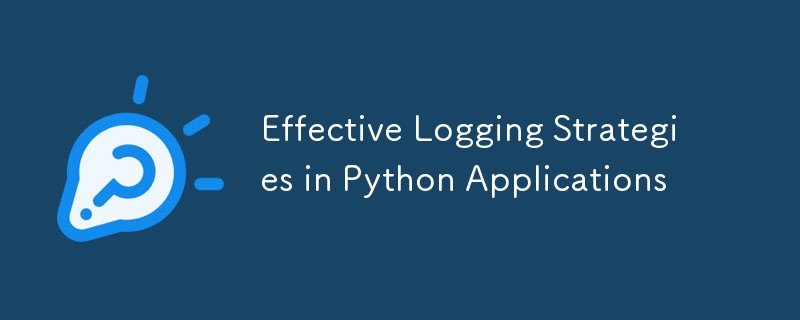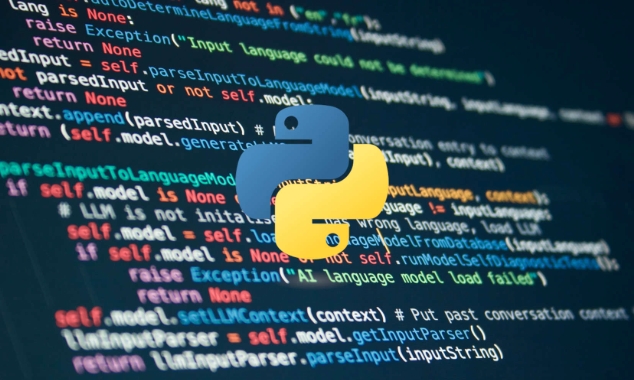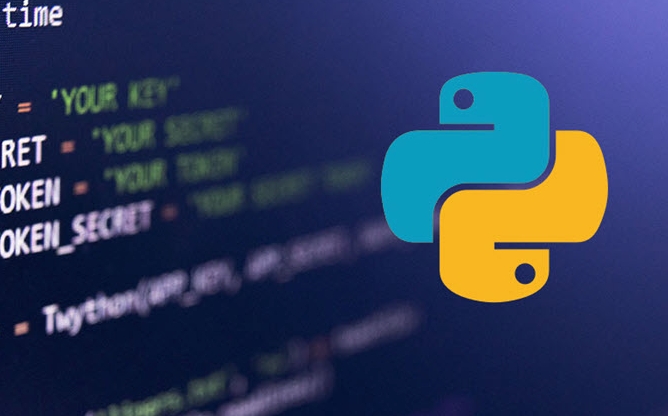Using the logging module instead of print to record logs and write files at a level, can improve debugging efficiency and problem positioning capabilities. 1. Priority is given to the use of logging modules, supporting hierarchical logging, format control and multi-position output; 2. Reasonably set the log level (DEBUG/INFO/WARNING/ERROR/CRITICAL) to distinguish the importance of information; 3. Write logs to files through RotatingFileHandler and rotate them to avoid excessive files; 4. Assign independent logger names to different modules to facilitate classification management and troubleshooting.

Writing good logs is an important part of debugging and maintaining Python applications. Many people just simply print it at the beginning, but print it seems too simple in projects, especially in systems where multiple people collaborate or run for a long time. A reasonable logging strategy can not only help you quickly locate problems, but also provide context information when errors occur.

Below are some practical log usage suggestions for most small and medium-sized projects.
Use logging module instead of print
Python's own logging module is much stronger than print. It supports different levels of logs (debug, info, warning, error, critical), can control the output format and output location, and can also record according to modules.

import logging
logging.basicConfig(level=logging.INFO)
logging.info("This is an info-level log")Compared to print, it is more flexible. For example, you can only let the error log output to the terminal and write the debug log to the file. In this way, there will be no interference with a large amount of debugging information in the production environment.
Logs at a level and set the level reasonably
Different information should correspond to different log levels:

- DEBUG : Used during development, detailed process, close before going online
- INFO : State changes in normal process, such as "Start processing request"
- WARNING : Potential problems, but the program can continue to run
- ERROR : An error occurs, affecting the current operation but not the overall operation
- CRITICAL : A critical error that may cause the program to terminate
For example:
If you are processing files uploaded by users and find that the file type is incorrect, you can record warning; if the reading fails, use error. In this way, you can know which level of the problem is wrong when you troubleshoot the problem.
Write logs to files and do rotation management
Online services cannot rely solely on terminals to view logs, and they usually write files. You can use FileHandler or better RotatingFileHandler to prevent log files from being too large.
from logging.handlers import RotatingFileHandler
handler = RotatingFileHandler("app.log", maxBytes=1024*1024, backupCount=5)
formatter = logging.Formatter('%(asctime)s - %(name)s - %(levelname)s - %(message)s')
handler.setFormatter(formatter)
logger = logging.getLogger(__name__)
logger.addHandler(handler)Here are a few key points:
- Set appropriate maxBytes to avoid a log file being too large
- Don't have too few backups or too many, 5 to 10 copies are more common
- Add time, module name, and level to the format to facilitate positioning
Assign independent logger names to different modules
If your project has multiple modules, such as database operations, network requests, task scheduling, etc., it is recommended to create your own logger for each module:
#db_utils.py
logger = logging.getLogger("myapp.db")
#api_server.py
logger = logging.getLogger("myapp.api")This allows them to control their log levels separately in the configuration, and it is easier to see which module is wrong.
Basically that's it. A good log is not the more, the better, but sometimes it can be found, and the noise that should not appear should be as low as possible. Take some time to configure clearly in the early stage, and the debugging time will be much more saved later.
The above is the detailed content of Effective Logging Strategies in Python Applications. For more information, please follow other related articles on the PHP Chinese website!

Hot AI Tools

Undress AI Tool
Undress images for free

Undresser.AI Undress
AI-powered app for creating realistic nude photos

AI Clothes Remover
Online AI tool for removing clothes from photos.

Clothoff.io
AI clothes remover

Video Face Swap
Swap faces in any video effortlessly with our completely free AI face swap tool!

Hot Article

Hot Tools

Notepad++7.3.1
Easy-to-use and free code editor

SublimeText3 Chinese version
Chinese version, very easy to use

Zend Studio 13.0.1
Powerful PHP integrated development environment

Dreamweaver CS6
Visual web development tools

SublimeText3 Mac version
God-level code editing software (SublimeText3)
 Polymorphism in python classes
Jul 05, 2025 am 02:58 AM
Polymorphism in python classes
Jul 05, 2025 am 02:58 AM
Polymorphism is a core concept in Python object-oriented programming, referring to "one interface, multiple implementations", allowing for unified processing of different types of objects. 1. Polymorphism is implemented through method rewriting. Subclasses can redefine parent class methods. For example, the spoke() method of Animal class has different implementations in Dog and Cat subclasses. 2. The practical uses of polymorphism include simplifying the code structure and enhancing scalability, such as calling the draw() method uniformly in the graphical drawing program, or handling the common behavior of different characters in game development. 3. Python implementation polymorphism needs to satisfy: the parent class defines a method, and the child class overrides the method, but does not require inheritance of the same parent class. As long as the object implements the same method, this is called the "duck type". 4. Things to note include the maintenance
 Python Function Arguments and Parameters
Jul 04, 2025 am 03:26 AM
Python Function Arguments and Parameters
Jul 04, 2025 am 03:26 AM
Parameters are placeholders when defining a function, while arguments are specific values ??passed in when calling. 1. Position parameters need to be passed in order, and incorrect order will lead to errors in the result; 2. Keyword parameters are specified by parameter names, which can change the order and improve readability; 3. Default parameter values ??are assigned when defined to avoid duplicate code, but variable objects should be avoided as default values; 4. args and *kwargs can handle uncertain number of parameters and are suitable for general interfaces or decorators, but should be used with caution to maintain readability.
 Explain Python generators and iterators.
Jul 05, 2025 am 02:55 AM
Explain Python generators and iterators.
Jul 05, 2025 am 02:55 AM
Iterators are objects that implement __iter__() and __next__() methods. The generator is a simplified version of iterators, which automatically implement these methods through the yield keyword. 1. The iterator returns an element every time he calls next() and throws a StopIteration exception when there are no more elements. 2. The generator uses function definition to generate data on demand, saving memory and supporting infinite sequences. 3. Use iterators when processing existing sets, use a generator when dynamically generating big data or lazy evaluation, such as loading line by line when reading large files. Note: Iterable objects such as lists are not iterators. They need to be recreated after the iterator reaches its end, and the generator can only traverse it once.
 Python `@classmethod` decorator explained
Jul 04, 2025 am 03:26 AM
Python `@classmethod` decorator explained
Jul 04, 2025 am 03:26 AM
A class method is a method defined in Python through the @classmethod decorator. Its first parameter is the class itself (cls), which is used to access or modify the class state. It can be called through a class or instance, which affects the entire class rather than a specific instance; for example, in the Person class, the show_count() method counts the number of objects created; when defining a class method, you need to use the @classmethod decorator and name the first parameter cls, such as the change_var(new_value) method to modify class variables; the class method is different from the instance method (self parameter) and static method (no automatic parameters), and is suitable for factory methods, alternative constructors, and management of class variables. Common uses include:
 How to handle API authentication in Python
Jul 13, 2025 am 02:22 AM
How to handle API authentication in Python
Jul 13, 2025 am 02:22 AM
The key to dealing with API authentication is to understand and use the authentication method correctly. 1. APIKey is the simplest authentication method, usually placed in the request header or URL parameters; 2. BasicAuth uses username and password for Base64 encoding transmission, which is suitable for internal systems; 3. OAuth2 needs to obtain the token first through client_id and client_secret, and then bring the BearerToken in the request header; 4. In order to deal with the token expiration, the token management class can be encapsulated and automatically refreshed the token; in short, selecting the appropriate method according to the document and safely storing the key information is the key.
 What are Python magic methods or dunder methods?
Jul 04, 2025 am 03:20 AM
What are Python magic methods or dunder methods?
Jul 04, 2025 am 03:20 AM
Python's magicmethods (or dunder methods) are special methods used to define the behavior of objects, which start and end with a double underscore. 1. They enable objects to respond to built-in operations, such as addition, comparison, string representation, etc.; 2. Common use cases include object initialization and representation (__init__, __repr__, __str__), arithmetic operations (__add__, __sub__, __mul__) and comparison operations (__eq__, ___lt__); 3. When using it, make sure that their behavior meets expectations. For example, __repr__ should return expressions of refactorable objects, and arithmetic methods should return new instances; 4. Overuse or confusing things should be avoided.
 How does Python memory management work?
Jul 04, 2025 am 03:26 AM
How does Python memory management work?
Jul 04, 2025 am 03:26 AM
Pythonmanagesmemoryautomaticallyusingreferencecountingandagarbagecollector.Referencecountingtrackshowmanyvariablesrefertoanobject,andwhenthecountreacheszero,thememoryisfreed.However,itcannothandlecircularreferences,wheretwoobjectsrefertoeachotherbuta
 Python `@property` decorator
Jul 04, 2025 am 03:28 AM
Python `@property` decorator
Jul 04, 2025 am 03:28 AM
@property is a decorator in Python used to masquerade methods as properties, allowing logical judgments or dynamic calculation of values ??when accessing properties. 1. It defines the getter method through the @property decorator, so that the outside calls the method like accessing attributes; 2. It can control the assignment behavior with .setter, such as the validity of the check value, if the .setter is not defined, it is read-only attribute; 3. It is suitable for scenes such as property assignment verification, dynamic generation of attribute values, and hiding internal implementation details; 4. When using it, please note that the attribute name is different from the private variable name to avoid dead loops, and is suitable for lightweight operations; 5. In the example, the Circle class restricts radius non-negative, and the Person class dynamically generates full_name attribute






